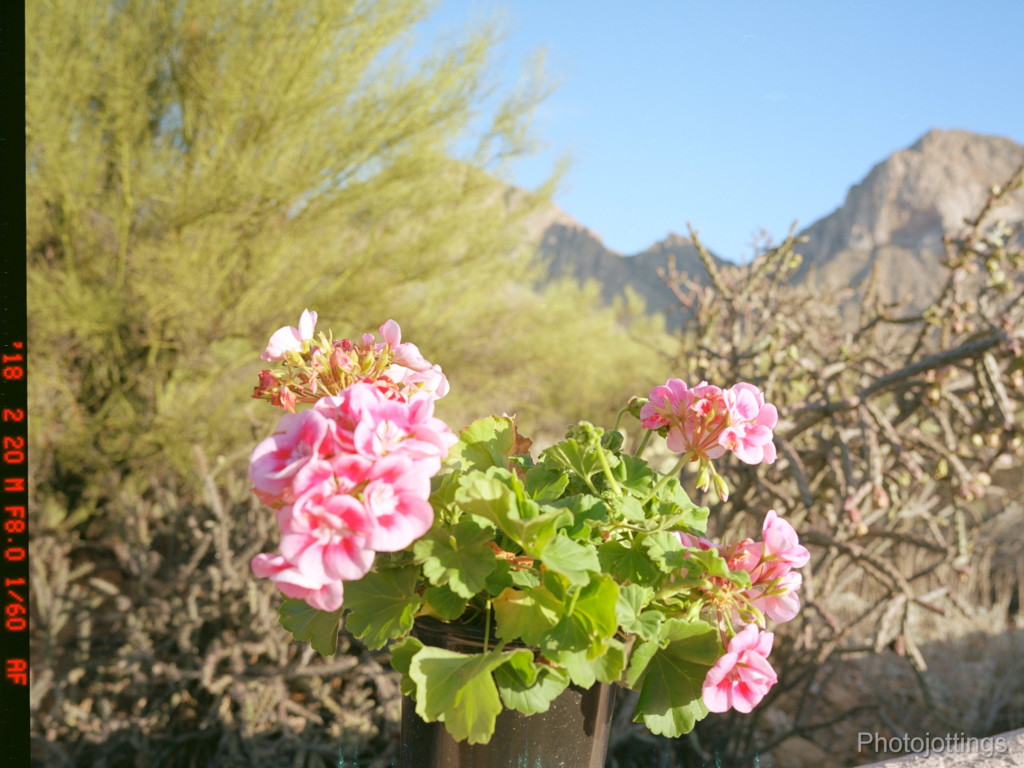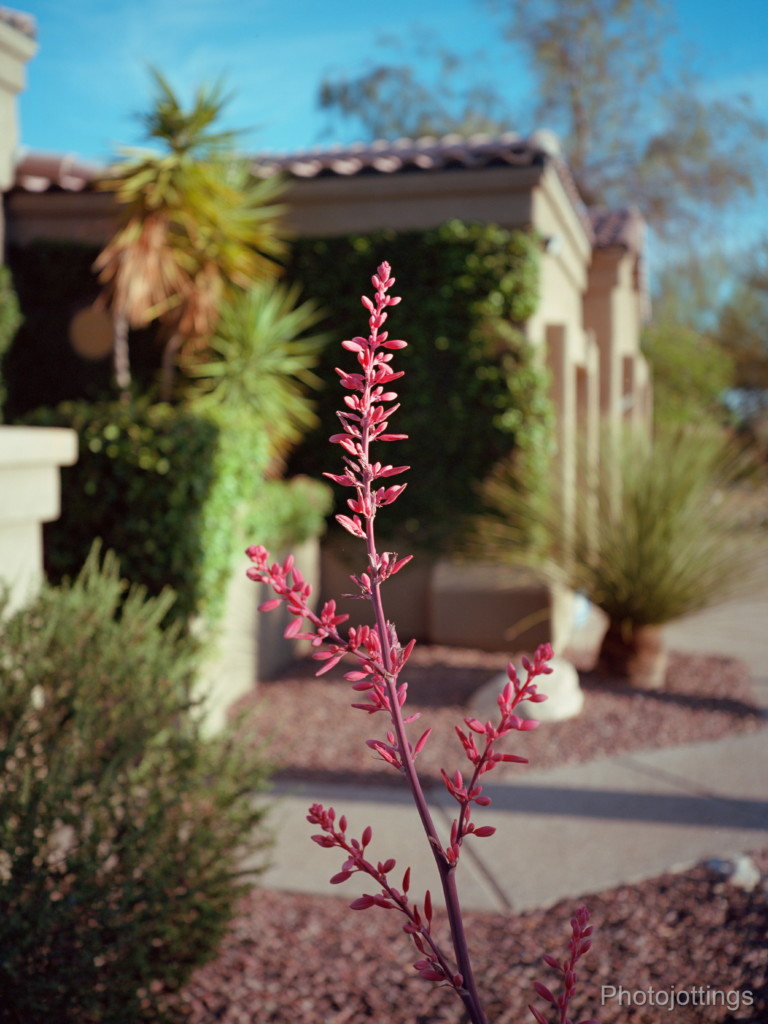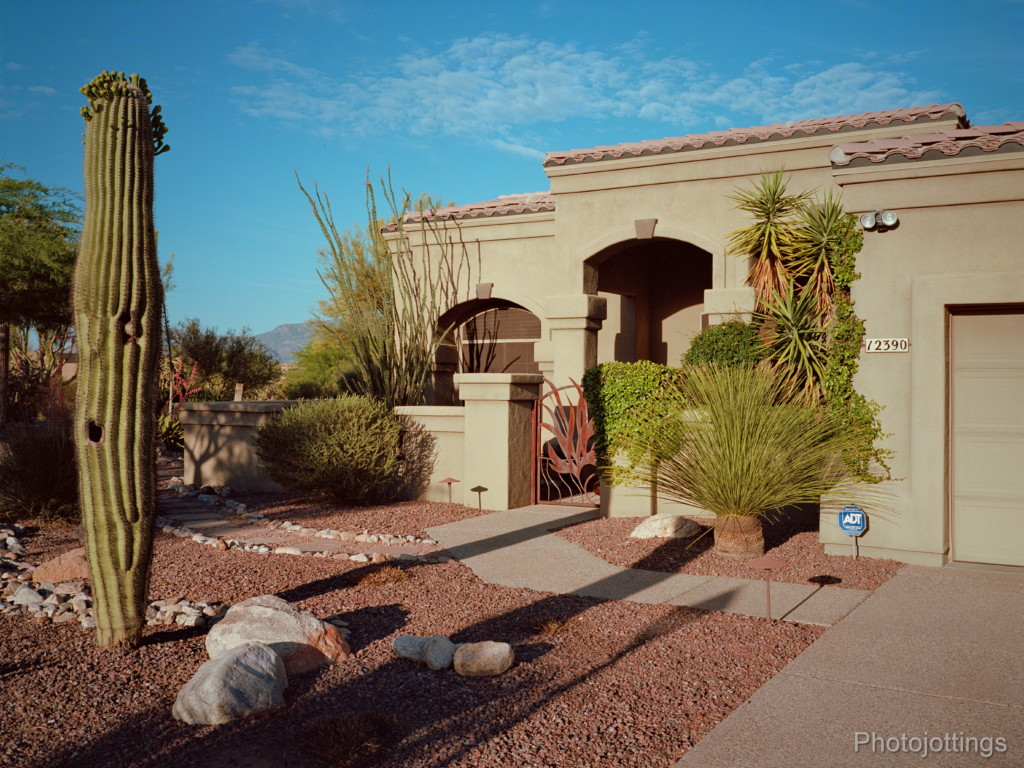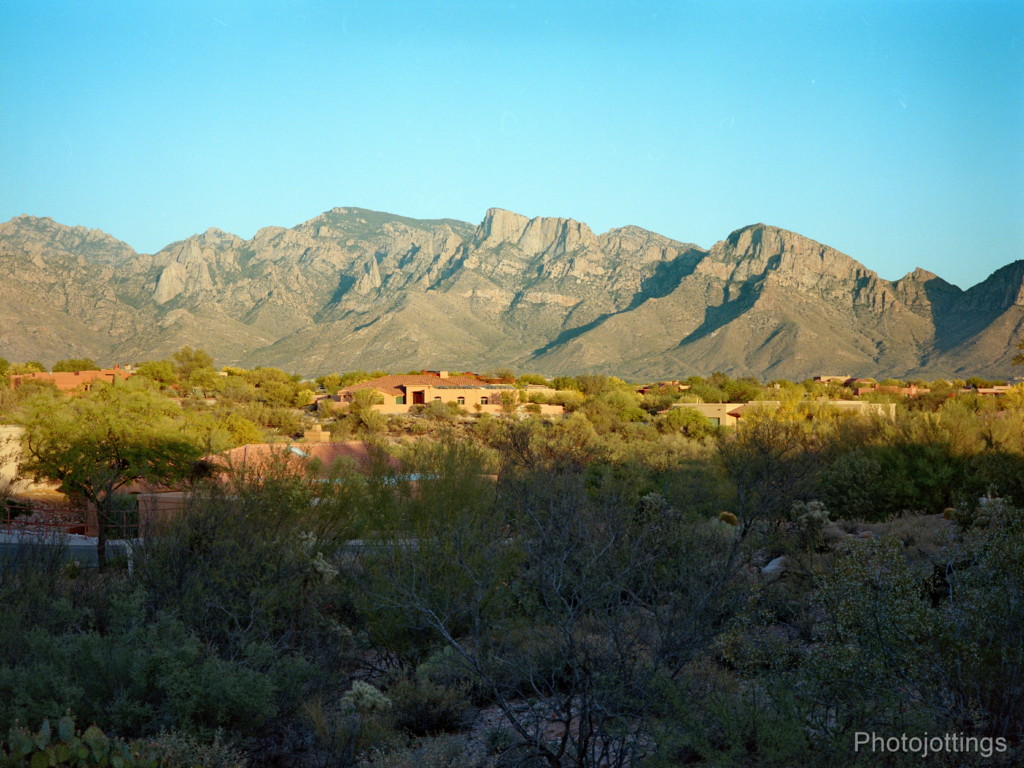
Nothing says ‘1990s’ better than a ‘Champagne’ colored electronics product, especially an expensive camera. The Fuji GA645Zi ‘Professional’ was the last, and most sophisticated model from Fuji’s ‘GA…’ medium format line. There were two others, the first had a 60mm, lens, the second model a wide angle 45mm, both reviewed here. The’Zi’ introduced a few handy features other than the zoom lens, like an adjustable viewfinder diopter; (great for people with less than perfect eyesight), a lens cap warning signal, (no more blank frames!), a more ergonomic placement of the shutter button, a revamped top plate, and a quieter focusing motor.
The new features were apparently pretty expensive; a February 1999 big mail-order house advertisement in Popular Photography magazine listed the price as $1849, which may have been discounted too! I’m guessing the Fuji GA645Zi was purchased mostly by rich amateurs rather than by professional photographers because of the limiting aspects of the slow zoom lens.
The Fuji GA645Zi lens is a ten element in ten group design with a 1.6x zoom range of 55-90mm, F/4.5-6.9. It has an equivalence in 135 format of approximately 34-56mm. Obviously, it’s a slow zoom, with a particularly narrow range; and you only get four zoom steps, or positions to choose from; 55mm, 65mm, 75mm and 90mm.
As I’ve said in the other Fuji GA reviews, people looking to step up to medium format from an automated 35mm camera like the Nikon 35Ti will love the simplicities of the Fuji GA645 models, they all function in a similar fashion, auto exposure, auto focus, automatic loading, advance and rewind. Even though the Fuji GA series are clearly bigger than 35mm cameras, you’ll notice the larger (2.7x) negatives right off, and you can have the camera imprint the shooting data below the film margins so you don’t have to write any of your settings down for future use.
The Fuji GA645Zi is pretty cool and has a lot of neat features, especially the zoom lens; (how many medium format cameras have a fixed zoom? not many I’d guess) So does this zoom have the qualities of a prime, or is it just another typical zoom, with fuzzy sides and low contrast on the long end? Let’s find out now!
Name; Fuji GA645Zi Zoom Professional.
Manufactured by; Fuji Photo Film Co., LTD., Tokyo, Japan.
Made in; Japan.
Date of manufacture; Approximately 1998.
Price; around $1849 USD in 1999 according to a photo magazine ad from a discount dealer. ebay prices start around $500 for a good working model, and go up past $900 if it comes with a low shutter count, box and all the original contents.
Build material; appears to be a mixture of metal and plastic. Fit and ‘champagne’ finish are very good.
Box contents; camera, instruction manual, a softcase?, neck strap, hood and cap.
Weight; my measurements ready to shoot; camera with hood and batteries, 32.4oz (919g).
Dimensions; my measurements; 6.4″ (165mm), 4.3″ (111mm) tall, and 3.0″ (75mm) deep power off and no hood; deep with power on, 55mm, 3.6″ (91mm), zoomed out to 90mm, 4.4″ (111mm). All dimensions include protrusions.
Focal length; 55-90mm. 65°-42° diagonal angle of view.
Aperture; F/4.5-F/6.9 maximum, and F/22-38 minimum. Auto or manually set in half stop increments.
ISO; 25-1600 manually set in 1/3 stop increments.
Focusing distance; 39″ to infinity, or 1.0m to infinity. The other two cameras with prime lenses claims the Auto focus sets the shooting distances in 870 steps, but uses 14 steps in the viewfinder. However, the manual for this camera doesn’t state any figures.
Viewfinder; ‘portrait’ orientation illuminating window type bright frame finder with automatic parallax correction. Manual states 88% coverage at infinity, 90% at 3 meters, with a magnification of 0.4-0.58x.
Light meter; TTF, (through the finder) center weighted light metering SPD photocell.
Approximate resolution; good film and technique will make very sharp 16×20″ prints. See sample images farther down the page.
Distortion; very low distortion at all focal lengths, see images below.
Light fall-off; I see moderate “corner shading” when shooting at wide apertures.
Color fringing; none that I notice.
Back ground blur or “bokeh;” looks good when close to the subject at wide apertures, see picture below.
Lens; Fujinon Super-EBC (electron beam coating) 10 elements in 10 groups design with a 1.6x zoom range of 55-90mm, F/4.5-6.9. Uses 52mm filters, B&H, Amazon, eBay.
Shutter and speed; super quiet electronic auto exposure inter-lens shutter with buzzer so you know when it trips! Speeds from 2 seconds up to 1/700, plus bulb mode.
Film; standard 120 or 220 roll, with a picture area of 56mm x 41.5mm. You get 16 pictures per 120 roll. The “6×4.5” picture area is 2.7x larger than 135 film.
Flash; built-in pop-up type, guide number of 12 at ISO 100, not user adjustable in power but it sounds like is has a crude distance integration system in ‘P’ mode. Fill flash only in aperture priority and manual modes. The owner’s manual suggests slow sync is available in ‘As’ mode, but I haven’t tried it yet.
Total shots indicator; push in the exposure compensation (+/-) button and hold, then turn the selecting dial from off to ‘ISO.’ It reads in increments of 100, and says it may have up to 200 test shots from the factory.
Power; two CR123a 3V lithium batteries, sometimes available at your local grocery/drug store, or these shops; B&H, Amazon, eBay. Fuji claims the batteries will last for 3000 shots with no flash use.
Accessories for this model; Fuji Zi flash bracket for use with the Zi model only, Fuji Strobe GA. See ad at the bottom for flash bracket info.
Crippling features and omissions; nothing really bad, the only minor item would be TTF metering, and that means you have to manually compensate when using filters.
Good features; excellent lens at all focal lengths, very accurate metering and focusing, auto parallax adjusting, self timer, auto first frame positioning, film advance and rewind, last shot beep, ±3.0 exposure compensation in half stop increments, and manual focusing via dial setting. I also like the pop-up flash, which is rare for a medium format camera.
Quirks; lens cap warning only warns you by blinking the viewfinder frame lines, but it doesn’t keep the shutter from tripping.
Problems; most of these cameras seem to suffer a bit from erratic “jumping” or “skipping” when using the up-down wheel. For example; when you want to go from F/9.5 to F/11, (which is one click), the settings may jump to F/22, or down to F4 etc. Apparently, according to several internet posts, some sort of factory lubricant used near the up-down dial has crept about, and is causing the problem. My camera has this problem too, but it really doesn’t bother me at this point. It sounds like it’s a fairly straight forward fix even for an amateur.
Other versions; a wide angle 45mm F/4 lens, and a 60mm F/4. There are also versions ending in “i” such as GA645Wi that have (among other things) two shutter buttons and a bar code film reader that automatically sets the film ISO.
Go here to see the owner’s manual, and make sure you tip the site owner.
Product shots with descriptions. Click pictures for larger versions.

The Fuji GA645Zi with box and cards. Hang tag reveals ¥195,000!

The Fuji GA645Zi powered on and ready for action. The odd looking hood slips over the lens barrel and turns to lock; my copy is quite hard to remove for some reason. There are two rectangular strap lugs on the left side of the camera; an upper and lower, and one upper on the right side. On the left side; or right side in the picture is the flash PC nipple.
The two little round windows under the ‘FujiFilm’ logo are the flash sensor, and AE light sensor. The white square is the finder light window. The red circle in the striped square is the finder window. The two mirrored windows in a rectangle are used for the AF system. The large red circle in the self timer indicator lamp. There are a couple of hidden devices inside the black housing above the lens.
The flash has to be manually popped up, it won’t do it automatically even in ‘P’ mode. The guide number is 12 at ISO 100.

On top we have the flash that’s in the stored position. The viewfinder diopter adjustment wheel is visible here; it goes from -3 to +1. The large mode and selecting dial (and little lock button below) has ISO, Program mode, two aperture priority modes, and full manual mode. The exposure compensation button is to the upper right; you press this while turning the large ‘up’ and ‘down’ dial (at lower rear) for setting ±3 compensation. This large dial also is used for adjusting the Data, ISO, focus, aperture and shutter speed settings.

The bottom plate holds two C123A batteries, a centered ¼-20 tripod socket, and a mid-roll rewind button. Note; the camera rewinds the film automatically after the last shot. The two circular covers are the film spool holders, you pop them out when you insert the film spools.

The lever type catch on the right side opens the rear cover. On the inside of the back cover we have the film pressure plate, which can be adjusted from 120 to 220 by pushing the red button beside the pressure plate, or you can do this after you load the film via AF/M button and up/down dial, the roll type will show up on the LCD. The two red buttons are for popping out the film loading knobs so you can load your film, then press the knobs up until they lock. While loading the film you can jog the take-up spool for easier flap insertion into the spool slot by turning the up-down dial; the power doesn’t have to be on for it to work.

The back cover is different from the other two versions. The film reminder slot is still there, but now we have an LCD, which has a bluish green light for dark environment; not turned on here. You only get basic data on the screen, like ISO, shot number, roll type, battery charge level, AF/MF, self timer, exposure compensation, focus distance, aperture, shutter speed etc; but unfortunately not all at once.

The lens is extended to 55mm in this image.
The latch for opening the back cover is located on the flat portion of the handgrip. The shutter button is located in a slightly lower position than what I’m used to, but it works. The little round shaped lens cap sensor is on the front of the lens, right by the ‘S’ in super-EBC, it’s hard to see here.

Zoomed in to 90mm, with a total travel of about 20mm.

The prime lens model is about the same size and weight of the zoom.

The big Fuji GW690III 6×9 is considerable larger and heavier than the GA645Zi, even more so than what the picture shows. I would much rather carry the smaller camera for snaps, but the 6×9 has twice the negative space, and requires no batteries.

Next to the Olympus 35 SP, the Fuji looks huge.

Note: here I used the same image from the 45mm F/4 wide angle review camera. This is the information you get on the margin of the film if you scan outside the picture area; I’m only showing one edge here, and you don’t normally scan beyond the picture area, especially if you’re using masks for flat scanning. I set the data to show the date and camera settings, but there are other settings to choose from. Reading from left to right, (or top down here), the date reads 18-2-20, or the 20th of February 2018. ‘M’ is manual mode, ‘F8.0’ is the aperture, ‘1/60’ is the shutter speed, and ‘AF’ is autofocus.
The data info is red for a positive image, but it will be bluish green when viewed as a negative. Also, the information is easy to read here, however, when you’re actually looking at the negative, it’s really small, and you’ll need a magnifying glass to read it.
Sample shots below.
Here are a few samples for your viewing pleasure. They’re about 5500 pixels on the long end. Scanned on a Nikon Coolscan 9000 ED. Click images for a larger version.

Close focus at F/4.5, 55mm. Pretty smooth highlight blur in the central area. Kodak Ektar 100.

ADT will get you!! Late afternoon house front at F/11, 55mm using Kodak Ektar 100.

Mountain range in late sun at F/8, 90mm; the maximum aperture at this focal length is F/6.9, so it’s less than a half stop from being wide open. Kodak Ektar 100.

Study, F/11, 2 seconds at 55mm. An Interior Designer staged this room, and I photographed it with the Fuji GA645Zi: it was almost the first shot from the camera after I bought it; so I had my fingers crossed!! I did have a Digital back-up though. No blown-out highlights in the white pillows in direct sun; use the same settings on your digital camera and both the pillows and couch turn into a nasty blotch. Kodak Ektar 100.

Ghosting and rainbow flare with the sun just inside the frame in late afternoon, 55mm, F/8. Kodak Ektar 100.

90mm, F/6.9, which is the maximum aperture at this focal length, taken at close focus. It’s still possible to get a nice blurred background with the camera. Kodak Portra 400.

90mm, F/11. The background is blurred nicely, the cactus could be an upper torso portrait; I’m guessing a couple of meters away from the two yellow flowers together in the center. Kodak Portra 400.

55mm. A little pincushion distortion visible if you overlay grid lines on the door bottom. I was going for the top edge of the roof in this series, but it’s stucco, and not all that flat, so the garage door at the bottom is a much better line to judge distortion.

75mm. Very minor barrel distortion noticeable along the bottom edge of the garage door.

90mm. Minor barrel distortion visible along the bottom edge of door.

Wai’ānapanapa State Park; 90mm, F/16, 1/90sec. Fuji Velvia 100.

Red Ginger at Hana; 55mm, F/8, 1/60sec. Fuji Velvia 100.

Wai’ānapanapa State Park, nice trail along the rocks in the background, scene is to the right of the third picture up; 55mm, F/8, 1/250sec. Fuji Velvia 100.
Test scene below.
All test shots are displayed at 5500 x 4125 pixels wide when enlarged, and that’s pretty close to all the resolution included in the film. Scanned on a Nikon Coolscan 9000 ED.
Here is our standard Mountain test scene using Kodak Ektar 100 film. A tripod was used, but no filters. Click to enlarge.
Note: I screwed up the 65mm test shots, so I wasn’t able to fit all zoom lengths on the roll.
55mm

F/4.5. Quite sharp with plenty of contrast here, even along the sides.

F/5.6, about the same as F/4.5.

F/8. A little sharper along the sides.

F/11. about the same as F/8.

F/16. The sides are the same, but the middle shows a bit of blur as a result of diffraction.
75mm

F/6.2. Very sharp in the middle area, just a tiny bit soft along the sides.

F/8. About the same as F/6.2.

F/11. About the same as F/8.

F/16. The sides are very sharp, as well as the middle, great results here.
90mm

F/6.9. Good centers, and sides.

F/11. The same as F/6.9.

F/16. Excellent sharpness across the frame, great for landscapes.
Comparison with Fuji GA645 with 60mm F/4 lens. Click picture for larger version.

Here’s a comparison between two Fuji cameras at wide angle, and at their maximum apertures. The Fuji GA645 has a 60mm prime lens with a maximum aperture of F/4. The Fuji GA645Zi is set at 55mm with a maximum aperture at that focal length of F/4.5, which is just a third of a stop slower, (less light).
I used the same test pictures from both cameras, however, they were taken at a different time, so the shadows and colors are not quite the same, but I tried to make them similar looking for the side by side comps. Also, the zoom is at 55mm, so it covers more area than the 60mm lens, that’s why things look smaller in the crops with the 55mm.
The top crops are from the right side of the image, the middle crops are from the centers, and the bottom are from the left side. The Fuji GA645 is on the left, the Fuji GA645Zi zoom on the right.
Even though the Fuji GA645 has a slightly longer 60mm lens, the Fuji zoom at the wide end is outperforming it across the frame at this setting, especially noticeable on the left side. Of course, as you stop down the differences diminish, but still, it’s a zoom compared to a prime!
Flash bracket for the Zi only.

A reader noted the differences between the flash brackets in the prime lens models, and the Zi. This ad from 1999 shows the proper flash bracket for the Zi.
Conclusion.
The Fuji GA645Zi turned in a great review, just like the 60mm, and 45mm models. They’re all fairly similar in operation, size and weight, but the Fuji GA645Zi is a slightly more modern camera, with a redesigned grip and shutter button placement, the mode dial is on top now and easier to access, and it now has a lighted LCD on the back. I like the adjustable diopter instead of having to buy an expensive eyepiece for correction as I did on the other two. Additionally, focus motor noise is much lower on the Zi; it fact, it’s almost quiet compared to the other two. Maybe Fuji used a different type of motor for this model.
Initially, I was skeptical of the zoom lens; after all, zoom lenses rarely outperform prime lenses, and sometimes they’re downright awful, especially when set to their maximum apertures; so I was quite surprised when I went back and started looking at the test images from the 60mm F/4 review, they seem a little dull compared to the zoom at 55mm. I was happy with the results with the 60mm, but now it looks like I might be shelving the 60mm, and using the ‘Zi’ from now on; the sharpness, color and contrast of the lens is really very impressive. Of course, the technical image quality is good at the longer zoom settings at wide apertures too, but great when stopped down to F/16. Additionally, the metering system on the Zi is excellent, and exposures are dead on with transparency (slide) film, but that’s no surprise as the other two models are too.
As far as lens characteristics goes; background blur looks pretty smooth overall on the wide end, but I haven’t taken too many shots at other apertures and zoom settings to determine the blur signature there. Also, I haven’t noticed any color fringing at any focal length, but I do see some ghosting and strong rainbow flare when the sun is inside the frame.
For people that are new to medium format and get intimidated easily: this is actually a great camera to start off with, it’s point and shoot simple. Exposure metering and focusing accuracy are both excellent, and there are several thoughtful features on the camera that both experts and novices will find useful, such as; the one shot remaining warning beep, this let’s you know when you’re about to run out of film! Auto rewind at the end of the roll; a lens cap warning signal in the viewfinder—the parallax lines blink when the cap is on, but unfortunately the shutter will still trip if pressed. The shutter is very quiet, so Fuji made it so you can have a little ‘beep’ go off (if you want) to let you know it tripped. Now as a final thought, the features above are nice to have, but the camera works great in ‘P’ or ‘program’ mode and that’s all you really need to take good pictures as far as the camera is concerned, however, visually pleasing compositions are another story!
That’s it for this review; two thumbs up for the spectacular Fuji GA645Zi ‘zoom’ camera!
Please consider buying through my links and help support the site. Thanks for visiting!